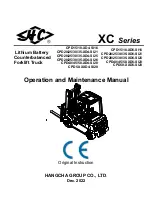
Operating Manual
Original Operating Manual
13
4.2.1 Bleeding the hydraulic system
Start the lift truck.
Rotate the rotator left and right several times.
Repeatedly cycle the fork positioner from the fully open to the fully closed position.
Inspect the hydraulic connections for leakage.
4.2.2 Adjustment after putting into service
The hydraulic system is under pressure. During work on hydraulic components
oil spurting out can cause injuries. Unload the system in accordance with the
operating instructions of the lift truck manufacturer. In the case of injuries
caused by high pressure oil, inform the works physician and seek out a
specialist immediately.
5.
Operation
5.1
General
At least once per working shift, the machine and equipment must be inspected for
visible damage and defects.
Repeat faults to your superior and have them rectified without delay.
Be aware of persons present in the area where you are working or driving and ensure
that they are not endangered.
Do not transport any load exceeding that specified on the residual load plate for the
particular combination of lift truck and attachment.
Note the load-bearing capacity of the attachment as stated on the rating plate. This
figure always represents the load carried by two or more fork arms.
The nominal capacity of the forks must exceed the load.
5.2
Load handling
Set the forks as wide apart as possible for the load to be carried.
Position the mast vertically and take up the load parallel to the floor.
Always transport pallets, boxes and containers using both forks.
Drive the attachment up to the load to maximum extent.
Raise the load about 300 mm and tilt the mast backwards.






























